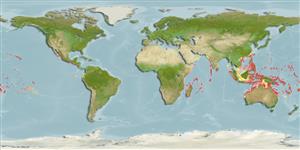Classification / Names
Common names from other countries
Main reference
Size / Weight / Age
Max length : 30.0 cm TL male/unsexed; (Ref. 48635); common length : 19.0 cm TL male/unsexed; (Ref. 9790)
Environment
Marine; reef-associated; non-migratory; depth range 1 - 40 m (Ref. 9790)
Climate / Range
Tropical, preferred ?; 26°N - 28°S
Distribution
Indo-Pacific: East Africa to the Tuamoto Islands, north to the Ryukyu Islands (Ref. 9710) and Taiwan, south to northern half of Australia; Marshall and Caroline islands in Micronesia.
Countries | FAO areas | Ecosystems | Occurrences | Introductions
Short description
Dorsal
spines
(total): 9;
Dorsal
soft rays
(total): 11-12;
Anal
spines: 0;
Anal
soft rays: 11 - 12. Body mottled with brown and white blotches above, whitish below; back crossed by 4-5 dark bands which may be indistinct (Ref. 4315). Lips with a row of small fleshy papillae. Base of lower opercular spine concealed by scales. Dorsal fin rays usually 11. Iris lappet bearing short branches with bifurcate tips.
IUCN Red List Status (Ref. 115185)
Threat to humans
Harmless
Human uses
Fisheries: subsistence fisheries
More information
ReferencesAquacultureAquaculture profileStrainsGeneticsAllele frequenciesHeritabilityDiseasesProcessingMass conversion
Tools
Special reports
Download XML
Internet sources
Estimates of some properties based on models
Phylogenetic diversity index
PD50 = 0.5625 many relatives (e.g. carps) 0.5 - 2.0 few relatives (e.g. lungfishes)
Trophic Level
3.9 ±0.67 se; Based on food items.
Resilience
High, minimum population doubling time less than 15 months (Preliminary K or Fecundity.)
Vulnerability
Low to moderate vulnerability (29 of 100)
Price category
